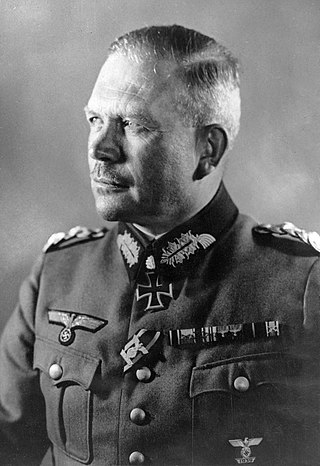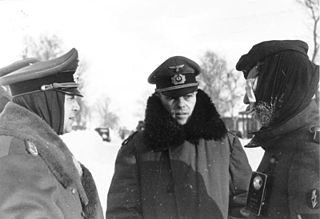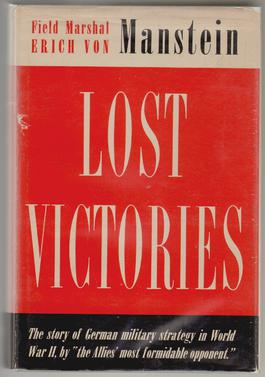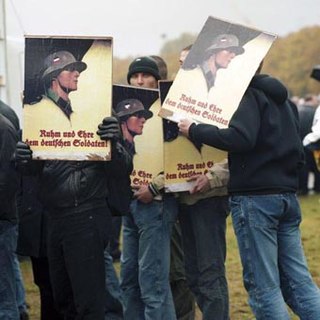
Blitzkrieg is a word used to describe a combined arms surprise attack using a rapid, overwhelming force concentration that may consist of armored and motorized or mechanized infantry formations, together with artillery, air assault and close air support, with intent to break through the opponent's lines of defense, dislocate the defenders, unbalance the enemies by making it difficult to respond to the continuously-changing front, and defeat them in a decisive Vernichtungsschlacht: a battle of annihilation.

Heinz Wilhelm Guderian was a German general during World War II who, after the war, became a successful memoirist. An early pioneer and advocate of the "blitzkrieg" approach, he played a central role in the development of the panzer division concept. In 1936, he became the Inspector of Motorized Troops.

Franz Bäke was a German officer and tank commander during World War II. He was a recipient of the Knight's Cross of the Iron Cross with Oak Leaves and Swords of Nazi Germany. In post-war popular culture, Bäke was memorialised in the historical fiction series Panzer Aces by German author Franz Kurowski.

Hermann Hoth was a German army commander, war criminal, and author. He served as a high-ranking panzer commander in the Wehrmacht during World War II, playing a prominent role in the Battle of France and on the Eastern Front. Contemporaries and later historians consider Hoth one of the most talented armoured warfare commanders of the war. He was a strong believer in Nazism, and units under his command committed several war crimes including the murder of prisoners of war and civilians.

The Third Battle of Kharkov was a series of battles on the Eastern Front of World War II, undertaken by Army Group South of Nazi Germany against the Soviet Red Army, around the city of Kharkov between 19 February and 15 March 1943. Known to the German side as the Donets Campaign, and in the Soviet Union as the Donbas and Kharkov operations, the German counterstrike led to the recapture of the cities of Kharkov and Belgorod.

Operation Bagration was the codename for the 1944 Soviet Byelorussian strategic offensive operation, a military campaign fought between 22 June and 19 August 1944 in Soviet Byelorussia in the Eastern Front of World War II, just over two weeks after the start of Operation Overlord in the west, causing Nazi Germany to have to fight on two major fronts at the same time. The Soviet Union destroyed 28 of 34 divisions of Army Group Centre and completely shattered the German front line. It was the biggest defeat in German military history, with around 450,000 German casualties, while 300,000 other German soldiers were cut off in the Courland Pocket.

Franz Ritter Halder was a German general and the chief of staff of the Army High Command (OKH) in Nazi Germany from 1938 until September 1942. During World War II, he directed the planning and implementation of Operation Barbarossa, the 1941 invasion of the Soviet Union. Halder became instrumental in the radicalisation of warfare on the Eastern Front. He had his staff draft both the Commissar Order and the Barbarossa Decree that allowed German soldiers to execute Soviet citizens for any reason without fear of later prosecution, leading to numerous war crimes and atrocities during the campaign. After the war, he had a decisive role in the development of the myth of the clean Wehrmacht.

Georg Otto Hermann Balck was a highly decorated officer of the German Army who served in both World War I and World War II, rising to the rank of General der Panzertruppe.

Friedrich von Mellenthin was a German general during World War II. A participant in most of the major campaigns of the war, he became known afterwards for his memoirs Panzer Battles, first published in 1956 and reprinted several times since then.

Leo Dietrich Franz Reichsfreiherr Geyr von Schweppenburg was a German general during World War II, noted for his pioneering stance and expertise in the field of armoured warfare. He commanded the 5th Panzer Army during the Invasion of Normandy, and later served as Inspector General of Armoured Troops. After the war he was involved in the development of the newly built German Army (Bundeswehr).

Richard Ruoff was a general in the Wehrmacht of Nazi Germany during World War II. He commanded the 4th Panzer Army and the 17th Army on the Eastern Front.
Panzer ace is a contemporary term used in English-speaking popular culture to describe highly decorated German tank ("panzer") commanders and crews during World War II. The Wehrmacht as well as British and American militaries did not recognise the concept of an "ace" during the war. The similar term, tank ace has been used post-war to describe highly regarded tanks commanders.

Verlorene Siege is the personal narrative of Erich von Manstein, a German field marshal during World War II. The book was first published in West Germany in 1955, then in Spain in 1956. Its English translation was published in 1958 for distribution in the UK and the US.

Franz Kurowski was a German author of fiction and non-fiction who specialised in World War II topics. He is best known for producing apologist, revisionist and semi-fictional works on the history of the war, including the popular English-language series Panzer Aces and Infantry Aces.

The myth of the clean Wehrmacht is the negationist notion that the regular German armed forces were not involved in the Holocaust or other war crimes during World War II. The myth, heavily promoted by German authors and military personnel after World War II, completely denies the culpability of the German military command in the planning and perpetration of war crimes. Even where the perpetration of war crimes and the waging of an extermination campaign, particularly in the Soviet Union – where the Nazis viewed the population as "sub-humans" ruled by "Jewish Bolshevik" conspirators – has been acknowledged, they are ascribed to the "Party soldiers corps", the Schutzstaffel (SS), but not the regular German military.

The Myth of the Eastern Front: The Nazi–Soviet War in American Popular Culture (2008) by Ronald Smelser and Edward J. Davies, is a historical analysis of the post-war myth of the "Clean Wehrmacht", the negative impact of the Wehrmacht and the Waffen-SS mythologies in popular culture, and the effects of historical negationism upon cultural perceptions of the Eastern Front of the Second World War.
The Waffen-SS, the combat branch of the paramilitary SS organisation of Nazi Germany, is often portrayed uncritically or admiringly in popular culture.

Panzer Aces is an English-language book series by the German author Franz Kurowski. Originally released in 1992 by J.J. Fedorowicz Publishing, a Canadian publisher of military literature, it was licensed in 2002 by the firm to American publishers Ballantine Books and Stackpole Books. The series' books were a commercial success and enjoyed a wide readership among the American public.
J.J. Fedorowicz Publishing is a Canadian publishing house that specialises in literature on the German armed forces of the World War II era. Its authors are both popular history writers such as Paul Carell and Franz Kurowski, along with the war-time veterans, including Kurt Meyer of the SS Division Hitlerjugend and Otto Weidinger of the SS Division Das Reich.

The Rommel Papers is the collected writings by the German World War II field marshal Erwin Rommel published in 1953.

















